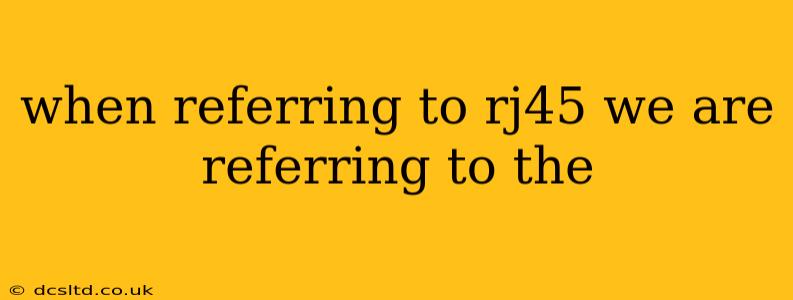When you hear "RJ45," you're actually referring to two closely related things: the connector itself and the cable it's typically used with. Let's break down each component:
What is an RJ45 Connector?
The RJ45 is a registered jack connector, specifically a type of 8P8C (8 position, 8 contact) modular connector. It's most commonly associated with Ethernet networking, but it can also be used for other applications that require eight wires. The "RJ" stands for "Registered Jack," a standard for connecting telephone equipment. While its origins are in telephony, its modern application is almost exclusively in data networking. The physical design of the connector, with its eight pins arranged in a specific pattern, allows for the connection of twisted-pair cables. You'll recognize it as the ubiquitous rectangular plastic piece at the end of most Ethernet cables.
What Type of Cable Uses RJ45 Connectors?
RJ45 connectors are almost always found on twisted-pair cables. These cables consist of pairs of insulated copper wires twisted together. This twisting helps reduce electromagnetic interference (EMI) and crosstalk, ensuring reliable data transmission. Different categories of twisted-pair cables (Cat5e, Cat6, Cat6a, Cat7, etc.) exist, each offering varying levels of performance and bandwidth capacity. The RJ45 connector provides the physical means to terminate these twisted-pair cables and connect them to networking devices like computers, routers, and switches.
What are the different types of RJ45 cables?
The most common types of RJ45 cables are categorized by their bandwidth capabilities and transmission speeds, indicated by their "Cat" rating:
- Cat5e (Category 5 Enhanced): A widely used standard, offering speeds up to 1 Gigabit Ethernet.
- Cat6 (Category 6): Provides improved performance over Cat5e, supporting Gigabit Ethernet and offering better performance at higher frequencies.
- Cat6a (Category 6 Augmented): A higher-performance version of Cat6, suitable for 10 Gigabit Ethernet over longer distances.
- Cat7 and Cat7a (Category 7 and Category 7 Augmented): These categories offer even higher bandwidth and are used in high-performance networks.
The choice of cable depends on the network's requirements and speed expectations. Choosing the correct cable is crucial for optimal network performance.
How is the RJ45 Connector Wired?
The wiring scheme of an RJ45 connector isn't arbitrary; it follows specific standards (like T568A and T568B) to ensure correct signal transmission. These standards dictate which wire goes into which pin on the connector. Incorrect wiring will result in a non-functional connection. While technically capable of many different applications with different wire arrangements, the near-universal use for RJ45 connections today is Ethernet, and T568A or T568B wiring are the standards followed.
What is the difference between T568A and T568B?
Both T568A and T568B are common RJ45 wiring standards. While they both work, it's essential to remain consistent within a single network to avoid compatibility problems. Mixing T568A and T568B can lead to network issues. The only difference lies in the order of the colored wires within the connector.
By understanding both the connector and the cable, you gain a comprehensive understanding of what RJ45 represents in the context of networking. It’s more than just a connector; it's a key component of modern data communication.
